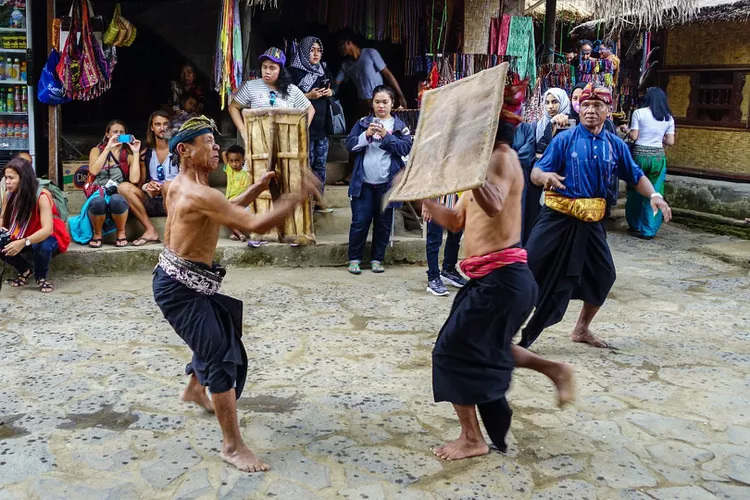Summary
- 1. Experience the Peresean Duel
- 2. Let Loose the Drums of War
- 3. Enjoy the Tari Amaq Tempengus Dance
- 4. Witness the Tari Petuk Dance
- 5. Explore Sasak Sade Village
- 6. Discover Strange Sasak Traditions
- 7. Sasak Women and Weaving
- 8. Find Ikat and Songket Cloth Bargains
- 9. Transportation to Sasak Sade Village
Experience the Peresean Duel
Whack! The bamboo baton hits the pepadu‘s buffalo-hide shield hard, and we feel the blow reverberate in the air, almost as if we’d taken a hit ourselves. As the crowd inches closer to get a better view of the peresean fight, the flurry of blows between the dueling pepadu feels like the batons are whizzing only inches away from us.
Thwack! One of the pepadu reels back, thrown off balance by the opposing pepadu‘s blow. The pakembar, or referee, immediately calls an end to the fight, before blood can be drawn.
Generations ago, drawing blood was the whole point of a peresean duel. The Sasak communities of the Indonesian island of Lombok used to stage such fights just before they planted rice in their paddies, believing that the more bloodshed during a duel, the heavier the rain would be that planting season.
The tamer peresean we’re witnessing right now occurs almost every day, whenever tourist buses disgorge their riders into the Sasak Sade Traditional Village in east Lombok.
Let Loose the Drums of War: Sasak Gendang Beleq

The Sasak living in Sade put on a rousing show for every tourist bus that comes by, starting with a performance by a traditional musical troupe, led by a gendang beleq (big drum).
The gendang beleq leads the rhythm, while the accompanying gongs provide the melody. The resulting music is energetic, perhaps hearkening back to the gendang beleq‘s original purpose as a war instrument. Historically, generals used it to rally their troops.
Send in the Clown: Tari Amaq Tempengus Dance

The troupe provides musical accompaniment to several acts performed by Sade’s menfolk. After the peresean duel, a lighter act takes center stage: Tari Amaq Tempengus, a court jester’s dance that was performed for tired soldiers returning from battle.
Amaq Tempengus’ movements resemble a stylized Sasak Charlie Chaplin, prancing around the small town square with flicks of his sarong for comical effect. His garish makeup adds to the whimsicality, as he flits from one viewer to another, delighting the audience and posing for photos.
Making the Cut: Tari Petuk Dance

Even Sasak kids get their time in the spotlight: the Tari Petuk dance, performed by boys around ten years old, captures the audience’s attention, gyrating as the gendang beleq hits a crescendo.
The moustaches painted on the boys’ faces feel almost like an inside joke, as the tari petuk is traditionally performed during the Sasak circumcision ceremony, a rite of passage to manhood.
The Village People: Exploring the Rest of Sasak Sade

After the show, visitors are encouraged to walk in Sasak Sade Village with a local guide. The village consists of 150 houses built in the traditional Sasak style, showcasing wooden pillars, woven-bamboo walls, and thatched roofs.
Approximately 700 Sasak people reside in Sade, all working together to preserve their culture. Traditional lamps, rice granaries, and weaving techniques thrive, allowing the Sasak identity to persist amidst modern changes.
Strange Sasak Traditions on Display

Fifteen generations of Sasak have lived in Sade for centuries, and some old customs remain strong. One such tradition involves swabbing floors with buffalo poop, believed to ward off mosquitoes and evil influences.
Sasak Women Doing the Weaving

The division of labor between men and women is evident in Sade. Men perform shows while women focus on weaving traditional cloth and selling them to visitors. Visitors can observe the time-intensive process of dyeing and weaving, often taking months to complete just a single piece.
Ikat and Songket Cloth Bargains on Every Corner

The paths of Sade’s town square feel like a vibrant market, with homes converted into storefronts offering colorful ikat and songket fabrics. Local artisans sell various products, creating opportunities for tourists to take home a piece of Sasak culture.
Transportation to Sasak Sade Village

To visit Sasak Sade Traditional Village, you can hire a car from Mataram to Pujut District, a picturesque 1.5-hour ride through scenic landscapes. You’ll need a paid guide to enter, costing about IDR 50,000 (approximately US$3.75). Arranging a tour package through your hotel in Mataram is a recommended option.
As is common in the travel industry, the writer was provided with complimentary services for review purposes.





